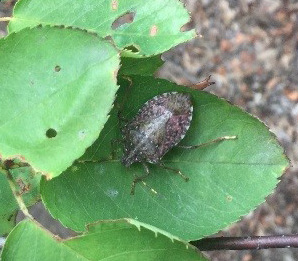Brown Marmorated Stink Bug (Halyomorpha halys)

The brown marmorated stink bug (BMSB) is a true bug in the order Hemiptera which was introduced from Asia.
The BMSB was first discovered in eastern Pennsylvania in 1998 and has quickly spread to almost all of the continental United States and several Canadian Provinces. In Indiana, it was first collected in Elkhart County in October 2010 and is now distributed statewide.
BMSB becomes a nuisance when it enters homes and other structures in the fall looking for shelter from the cold.
Damage
BMSB is polyphagous, meaning it can feed on a variety of material including fruits, vegetables, seeds and other plant tissues.
This pest can cause major damage in orchards by piercing fruit, leaving it unable to be sold. It can also wreak havoc on soybeans and corn. BMSB are edge feeders, meaning that they will start feeding on the edge of a field and work toward the center.
BMSB has shown signs that it could develop some resistance to chemical control, which could have serious implications for the future.
Nuisance pest
Adult BMSB often find shelter for the winter in the cracks and crevices of our homes.
Seal cracks and gaps around windows, doors, attics, foundations, vents and air conditioners that could serve as entrance points.
If stink bugs enter your home, there are a couple of ways to get rid of them. One of the easiest methods is to collect them with a garage vacuum. Empty the vacuum immediately into a bucket of soapy water where the sting bugs will drown. Another method is to use a pie pan full of soapy water under a desk lamp. BMSB are attracted to the light. They will fly around it, fall into the water and drown.
Potential biological control
There are a limited number of control options for organic producers and homeowners, including trap crops and physical barriers. There has been some hope that a biological control may help. Trissolcus japonicas, the samurai wasp, is a parasitoid that lays eggs inside the egg of a BMSB. The wasp larvae then feeds on the developing BMSB and kills it. In 2014, the samurai wasp was discovered in wild populations parasitizing BMSB eggs on the East Coast as and near Vancouver. It is hypothesized that the Samurai wasp was probably introduced simultaneously with BMSB. The wasp has been kept in a federal quarantine facility since 2007 and has been undergoing evaluation for possible use as a wide-spread biological control agent.
